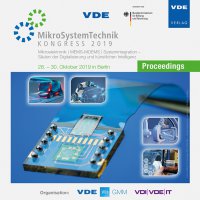Influence of electrochemical operating conditions on the microme-chanical properties of electrodeposited Nickel-Cobalt alloys for fabrication of microtools
Konferenz: MikroSystemTechnik 2019 - Kongress
28.10.2019 - 30.10.2019 in Berlin, Deutschland
Tagungsband: MikroSystemTechnik 2019
Seiten: 4Sprache: EnglischTyp: PDF
Persönliche VDE-Mitglieder erhalten auf diesen Artikel 10% Rabatt
Autoren:
Khazi, Isman (Institute of Microsystems Technology (IMST), Faculty of Mechanical & Medical Engineering, Robert Gerwig-Platz 1, 78120 Furtwangen im Schwarzwald, Germany & Department of Microsystems Engineering (IMTEK), University of Freiburg, Georges-Köhler-Allee 103, 79110 Freiburg im Breisgau, Germany)
Mescheder, Ulrich (Institute of Microsystems Technology (IMST), Faculty of Mechanical & Medical Engineering, Robert Gerwig-Platz 1, 78120 Furtwangen im Schwarzwald, Germany)
Inhalt:
The influence of the bath pH value and type of electrodeposition modes, namely potentiostatic and galvanostatic deposition modes on the microhardness of electrodeposited Nickel-Cobalt (eNiCo) alloys is investigated. The alloy composition, the surface morphology and the resultant micromechanical properties of the eNiCo alloys depend significantly on the operating conditions. The deposition process of eNiCo alloys belongs to the type anomalous co-deposition, wherein the degree of anomaly decreases with increasing applied potential and applied current density and increases with an increase in the bath pH value. In case of potentiostatic deposition, the onset reduction potential is obtained by linear sweep voltammetry and the highest microhardness value of 656 HV0.1 is obtained for a potential (-0.65V) close to the onset reduction potential (-0.4V). The microhardness value is found to decrease with an increase in the applied potential. Whereas in case of galvanostatic deposition mode, the microhardness value increased with an increase in applied current density up to 40 mA/cm2 with a maximal microhardness value of 603 HV0.1 and decreased on further increase in the applied current density. A bath pH value < 3 results in eNiCo alloys with lower microhardness value and an optimum bath pH value of 4-5 is found to fabricate eNiCo alloys (galvanostatic) with high microhardness value in the range of 530 HV0.3-600 HV0.3. Optimum process conditions are used for the fabrication of a microdie (die hole width: 60 µm and depth: 100 µm) using a structured silicon wafer with platinum plating base as a mold. The cross-sectional microhardness profile shows a homogenous microhardness distribution along the die hole and rest of the bulk material of the microdie.


